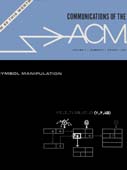PM, a system for polynomial manipulation
PM is an IBM 7094 program system for formal manipulation of polynomials in any number of variables, with integral coefficients unrestricted in size. Some of the formal opeartions which can be performed by the system are sums, differences, products, quotients, derivatives, substitutions and greatest common divisors. PM is based on the REFCO III list processing system, which is described and compared with the LISP and SLIP systems. The PM subroutines for arithmetic of large integers are described as constituting an independently useful subsystem. PM is compared with the ALPAK system in several respects, including the choices of canonical forms for polynomials. A new algorithm for polynomial greatest common divisor calculation is mentioned, and examples are included to illustrate its superiority.




